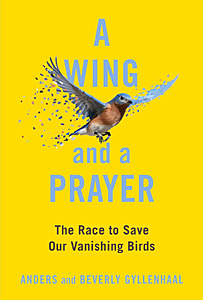Volume 28 Issue 4, Fall 2023
Review by Steve Allen
“Birds Are Vanishing From North America.”
That was the 2019 headline in The New York Times following publication of a report in the journal Nature by a coalition of bird experts, statisticians, and other scientists concluding that since 1970, the bird population of North America has been reduced by almost 30%, roughly 2.9 billion birds.
A Wing and a Prayer, by journalists Anders and Beverly Gyllenhall, is the story of that report’s creation, and efforts across the United States and Canada to save threatened and endangered bird species. Their story is something of an odyssey, as the authors traveled across the U.S. multiple times, living in an Airstream trailer for a year, meeting with experts and working with naturalists in the field.
 Three dozen bird scientists from around the country were at an annual meeting at the Cornell Laboratory of Ornithology in 2017 when a guest asked, “Exactly how many birds have we lost altogether?” This question stopped the meeting in its tracks as the experts realized they didn’t know the answer but committed to finding it.
Three dozen bird scientists from around the country were at an annual meeting at the Cornell Laboratory of Ornithology in 2017 when a guest asked, “Exactly how many birds have we lost altogether?” This question stopped the meeting in its tracks as the experts realized they didn’t know the answer but committed to finding it.
They soon realized that the data they needed already existed, though not all in one place. The results of annual censuses like the Christmas Bird Count, Breeding Bird Surveys, and others had never been aggregated, mostly because much of it was still in analog form, and because the ability to do “big data” collection was a relatively new technology.
After two years of statistical work, the shocking results were in. The statisticians running the data recalculated several times, always coming to the same conclusion: 3 billion birds were missing. The report’s publication led to media headlines, public outcry, and the creation of the 3 Billion Bird Project to raise money and formulate a strategy to reverse the decline.
Currently 89 bird species are listed as endangered or threatened under the Endangered Species Act, and almost 350 others listed as Birds of Conservation Concern by the U.S. Fish and Wildlife Service. That’s all well and good, but Fish and Wildlife is seriously underfunded, and it takes many years for a bird to move onto the endangered list.
In some cases, the situation is so dire that scientists are taking extreme measures to save a species. The small California Spotted Owl is on the verge of extinction largely because of loss of territory to Barred Owls, a well-loved species here in the East but considered invasive in the West. After much soul-searching, the decision was made to eradicate Barred Owls in the Spotted Owl’s territory, so naturalists hunted and shot them. This program appears to be working after three years, as the Barred Owl population seems to have been reduced by about 90% while the Spotted Owls have recovered a lot of territory.
Hawaii is “the extinction capitol of the world,” having already lost 70% of its native bird species with many more endangered. On Mauna Kea, birds are threatened due to habitat destruction by introduced species, pushing native birds up the volcano towards the tree line; and from a malaria epidemic. One solution has been to release millions of infertile male mosquitos in the area, hoping that will reduce the mosquito population before the birds go extinct.
There are also success stories. Waterfowl like ducks and geese prized by hunters were extremely threatened in the mid-1900s. A coalition of hunting groups and preservationists coalesced into the organization Ducks Unlimited, which has been spectacularly successful in saving these birds, mostly by conserving millions of acres of land, funded at the state level by fees for hunting licenses and at the federal level by “Duck Stamps” issued by the U.S. Postal Service.
In the period covered by the report, game birds have increased by 56% while all other categories have decreased. At the same time, attempts to replicate the waterfowl program for other birds have not been successful, although some recent proposals such as a tax on birdseed, bird feeders, and binoculars might move forward at some point.
A Wing and a Prayer is an extraordinary work, and should be required reading for everyone who loves birds, which is to say for everyone.

